Read The
Current Issue
High Point
Heading out to climb the Grand Teton isn’t always the adventure you expect.
By Lexey Wauters // photography by david stubbs
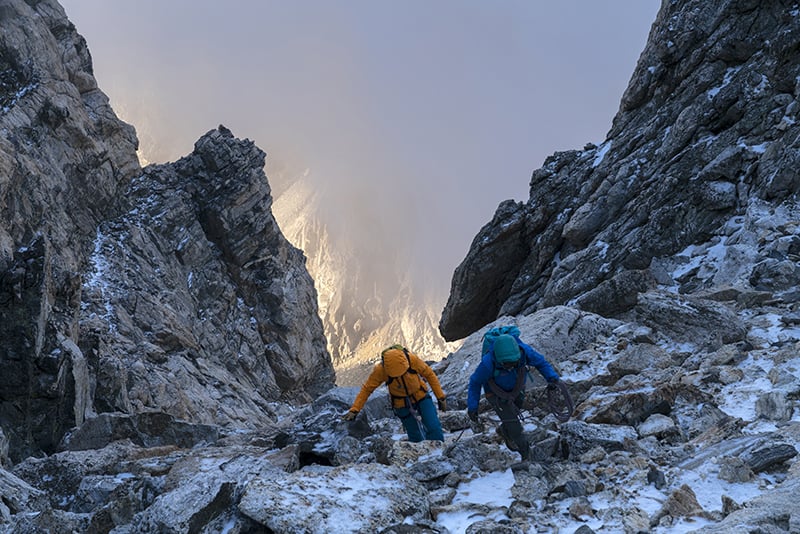
Exum guide Jessica Baker and the author make their way up the Grand Teton from Exum’s high-altitude camp on the Lower Saddle.
AT ABOUT 12,500 feet in elevation on the southern side of the Grand Teton, Jessica Baker, a guide with Exum Mountain Guides, and I are shrouded in clouds and battling inhospitable conditions. We can see only a few yards in front of us, clear ice coats the rocks beneath our feet, and the wind is steady at 25 miles per hour. We started hiking at 5 a.m. up from the Lower Saddle, an overnight camp at an altitude of 11,692 feet on a col between the Middle and Grand Tetons that’s used by Exum for its clients. The “hike” is up a steep couloir filled with lots of loose rock. I find myself often using my hands. Other climbers pass us, both ascending and descending. They are ghosts in the mist.
Our goal is the 13,775-foot summit of the Grand Teton, the highest peak in Grand Teton National Park (GTNP) and the second-tallest in Wyoming. (Gannett Peak in the Wind River Range is about 35 feet higher.) There are numerous routes to the Grand’s summit. Baker and I, like the majority of Exum groups, are heading for the Upper Exum Ridge, named after the first person to climb it, Glenn Exum, who made a solo ascent of the ridge in 1930. Modern rock climbing grades rate it a 5.5, which is at the higher end of easy. (5.0 to 5.7 is considered easy; 5.8 to 5.10 is considered intermediate; 5.11 to 5.12 is hard; and 5.13 to 5.15 is reserved for the very elite.)
To get to the start of the Upper Exum from the Lower Saddle, a climber hikes up to a prominent feature called Wall Street, an upward-sloping ledge that gradually tapers to nothing at an elevation of about 12,800 feet. Here climbers do the “step across,” which is exactly what it sounds like—stepping across a span of air—to gain the route and ridge. And then the real climbing starts. From here to the summit it’s a gain of slightly under a thousand vertical feet.
After about two hours of walking we reach the aptly named Needle Buttress. There is just enough visibility to see Wall Street. It’s coated with a thin layer of white: snow.
Exum and Jackson Hole Mountain Guides, the only two companies permitted to guide climbers up the Grand, offer trips from June until September. Clients at the beginning and end of the season are warned that snow and/or ice could be factors. Baker and I are on the mountain the first weekend in September, definitely the end of the season. We can’t help but laugh when we overhear a nearby climber say, “It looked sunnier in the brochure.”
We can’t help but laugh when we overhear a nearby climber say, “It looked sunnier in the brochure.”
THE FIRST ASCENT of the Grand is contested. It was either first climbed in 1872 or 1898. William Owen and Franklin Spaulding definitely climbed the peak in 1898; there’s photographic proof. But Nathaniel P. Langford and James Stevenson, members of the 1872 Hayden Survey, claimed they reached the summit in 1872. But they had no proof to substantiate their claim, and their description of the summit they reached is closer to that of the Enclosure, a side peak of the Grand, than it is to the Grand’s summit. Owen and Spaulding climbed the Grand via a route on the west side that today bears their names. The Owen-Spaulding route is the easiest way to the summit, but still requires technical climbing skill and equipment. (Today it is the most popular summit route.)
After Owen and Spaulding’s climb, the summit went unvisited again until 1923, when three Montana State University students climbed it August 25. Two days later, Eleanor Davis became the first woman to stand on the peak’s summit. Paul Petzoldt, a southern Idaho transplant from Iowa, climbed the peak in 1924. He was only 16 years old at the time. By 1925, Petzoldt was guiding others up the mountain. He met Glenn Exum, a music student at the University of Idaho at the time, in 1929. That same year, Exum and Petzoldt formed a partnership that became the Exum-Petzoldt School of American Mountaineering. It was the following year that Exum pioneered the route up the south ridge that now bears his name, and that Exum Mountain Guides takes most of its clients up. In a departure from the traditional European guiding method of “short-roping” guests up and lowering them down, Exum-Petzoldt guides taught guests basic climbing skills. Never-ever climbers learned balance and foot placement, rope handling, knots, rappelling, and belaying. This is the school that is today Exum Mountain Guides. (Notably, Petzoldt went on to found NOLS, the National Outdoor Leadership School.)
BECAUSE I AM a never-ever climber, before I can head up the Grand with Baker I was required to do a six-hour basic rock climbing class, aka “climbing school.” It doesn’t always happen that clients get the same guide for the Grand as they get for climbing school, but I was lucky to get Baker for both. The 43-year-old mother of two has guided in Alaska, Norway, the Andes, Canada, and the Arctic, and, here in the Tetons with Exum, since 2006. She’s guided clients up the Grand about 130 times.
Exum’s climbing school is on a wall of rocks on the western shore of Jenny Lake. There I learned friction walking (ascending a smooth angled rock surface using your weight and balance, and shoes with really sticky rubber) and how to set up a belay and to rappel. At the end of the day I felt more prepared, albeit with a very healthy dose of nerves.
After a final slab pitch slick with rime ice—over which Baker keeps me on a tight belay—we’re on top, and we have the enclosure to ourselves.
IT IS TWO weeks after climbing school that Baker and I stare across at a snow-covered Wall Street. Our climb started the day before at the Lupine Meadows Trailhead, one of the most popular in GTNP because it is the starting point for trails into Garnet Canyon and to Amphitheater and Surprise Lakes. It is the former that, eventually, leads to the Grand Teton. Undaunted by threatening clouds, we leave the trailhead at around 10 a.m.
At a very moderate pace and with plenty of breaks we cover the seven(ish) miles and 5,000 vertical feet from the parking lot to Exum’s temporary Quonset hut on the Lower Saddle in about five hours. Rain squalls move over us several times during the day, some of them drenching downpours, others light showers.
That night, the hut, which sits on a col, or saddle, that looks into both Idaho (to the west) and over Jackson Hole (east), is the overnight home for four other Exum clients. (Jackson Hole Mountain Guides’ summer base camp is about 700 feet lower in an area called the Upper Moraine.) Although quarters are close—the hut is 25-by-15 feet—the atmosphere is convivial. After dinner—I carried up lasagna for myself; other climbers eat dehydrated meals—Baker gives me a general preview of the morning. She will wake me up at 3:30 a.m., we’ll have coffee and breakfast, assess the weather, pack our day bags, and start hiking up towards the route.
With such an early start, we go to bed early, but sleep initially proves elusive. The wind picks up and the canvas hut billows and buffets. Rain and hail start shortly after midnight. The weather outside sounds horrible, but inside the hut I am cozy. I do finally drift off and then sleep hard.
We leave the hut at 5 a.m. The rain has stopped, but clouds hang low. Baker’s pack bulges with climbing gear; I carry only my personal gear, clothing, snacks, and lunch. The rocks glisten wet in the artificial light cast by our headlamps. Our progress is slow but consistent and the footing is slick. While it rained on the Lower Saddle, above it the precipitation fell as sleet and snow. We negotiate features including the Briggs Slab, Black Rock Chimney, and the Dance Floor.
It is around 7 a.m. when we arrive at Needle Buttress and get our first view of Wall Street and the snow covering it. Immediately Baker says, “It’s a deal breaker.” The precipitous ledge is tricky enough when dry; slick with snow and ice it’s too dangerous. There is no way onto the Upper Exum Ridge other than Wall Street. It is a bittersweet moment. I am happy not to have to do a snow-covered Wall Street, but disappointed I will not stand on the summit of the Grand Teton today. But not too disappointed; it’s thrilling just to be out on the mountain.
It could be argued the consolation prize Baker comes up with is at least as interesting as summiting the Grand. A couple of hours after abandoning our intended climb, we stand atop the Enclosure, a 13,285-foot-tall spire to the west of the Grand. The second tallest summit in GTNP, the feature got its name from a small horseshoe-shaped “enclosure” early white climbers found on its summit; it is believed Native Americans built this as part of vision quest rituals. The scramble to the Enclosure is generally an easy effort with considerably less exposure, and therefore risk, than our planned route up the Grand.
After a final slab pitch slick with rime ice—over which Baker keeps me on a tight belay—we’re on top, and we have it to ourselves. Clouds backlit by a weakly emerging sun swirl around. Sunspots reveal glimpses of peaks around us, and then clouds again swallow the peaks. I find I don’t care we’re not on the summit of the Grand. I’m standing on a spot from which I can climb no higher. To get here, I friction walked, belayed, and rappelled—none of which I had ever done a month ago. It is exhilarating to be on this peak in this otherworldly atmosphere.
The Enclosure was not the adventure I set out on. But as often happens in the wilderness, the adventure I do have ends up being profoundly and distinctly what I want. JH
NUTS & BOLTS
Exum Mountain Guides’ Classic Grand experience is a four-day program that includes two days of group instruction followed by a two-day climb. Exum also offers private guided climbs. The Classic Grand starts at $1,055/person; a private guided climb starts at $2055/person; 307/733-2297; exumguides.com. Jackson Hole Mountain Guides offers 2-, 3-, and 4-day trips that include climbing instruction. Group climbs from $1580/ person; private trips from $2,370; 307/733-4979; jhmg.com
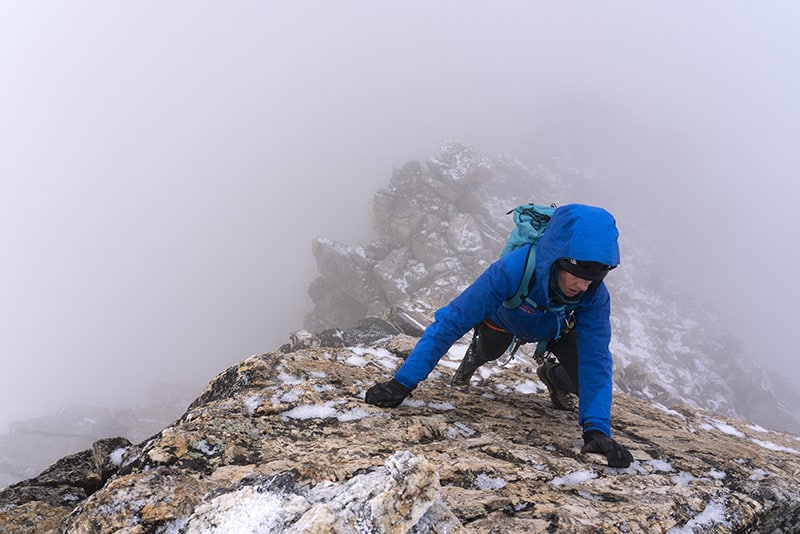
Because of weather, Baker and the author were not able to climb the Grand. Instead they went up the Enclosure, a 13,285-foot-tall spire to the west of the Grand Teton that is less technical.
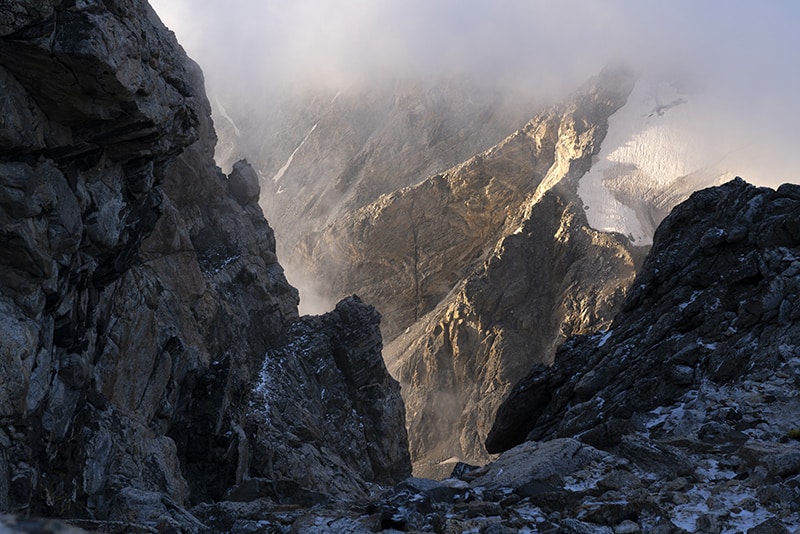
Aspiring climbers of the Grand Teton who go with Exum Mountain Guides start their climb with a hike up from the Lower Saddle, seen below with a patch of snow on it. Exum maintains a temporary Quonset hut there where clients spend the night before their summit day.
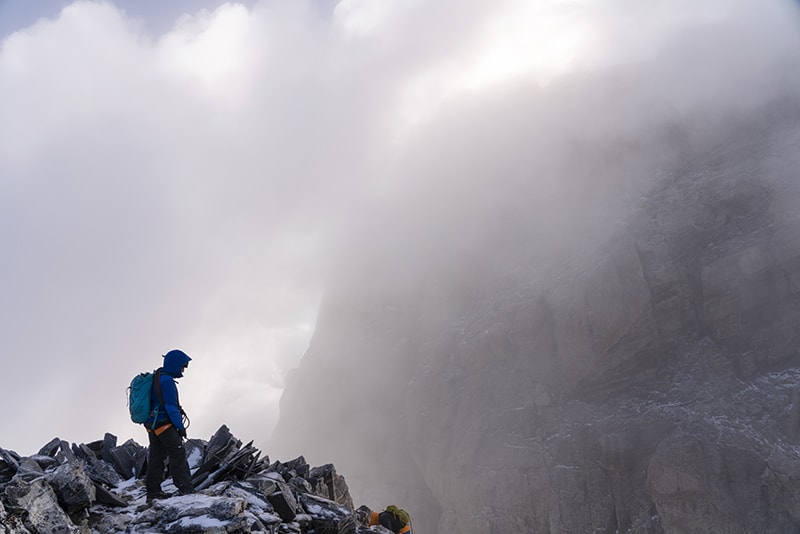
Exum guide Jessica Baker on the summit of the Enclosure, a consolation prize after weather kept her and client Lexey Wauters from climbing the Grand Teton.
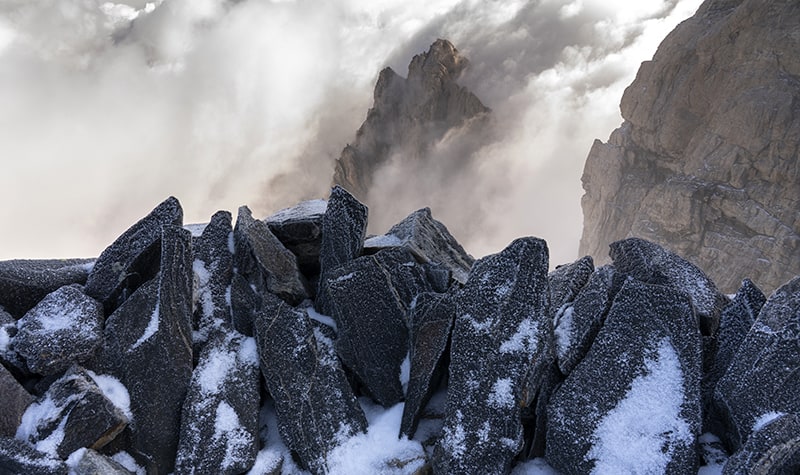
Guides usually take clients up the Grand Teton between June and early September; clients at the end of the season are warned that snow and/or ice could diminish their chances of summiting. It is sometimes possible to do a less difficult climb if the ascent of the Grand is deemed too dangerous.




